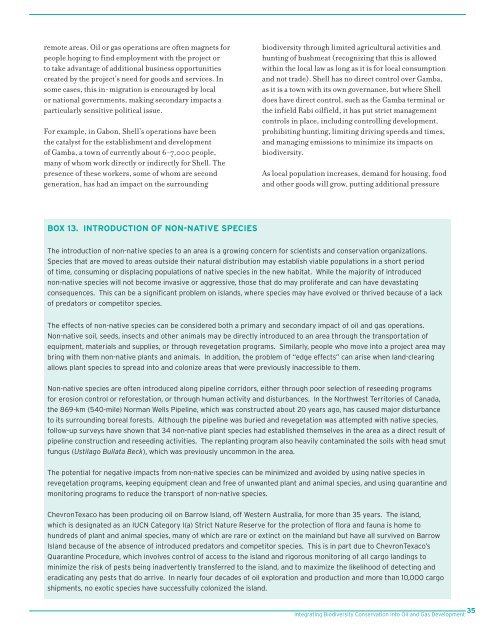Integrating Biodiversity Conservation into Oil and Gas ... - EBI
Integrating Biodiversity Conservation into Oil and Gas ... - EBI
Integrating Biodiversity Conservation into Oil and Gas ... - EBI
Create successful ePaper yourself
Turn your PDF publications into a flip-book with our unique Google optimized e-Paper software.
emote areas. <strong>Oil</strong> or gas operations are often magnets for<br />
people hoping to find employment with the project or<br />
to take advantage of additional business opportunities<br />
created by the project’s need for goods <strong>and</strong> services. In<br />
some cases, this in-migration is encouraged by local<br />
or national governments, making secondary impacts a<br />
particularly sensitive political issue.<br />
For example, in Gabon, Shell’s operations have been<br />
the catalyst for the establishment <strong>and</strong> development<br />
of Gamba, a town of currently about 6-7,000 people,<br />
many of whom work directly or indirectly for Shell. The<br />
presence of these workers, some of whom are second<br />
generation, has had an impact on the surrounding<br />
biodiversity through limited agricultural activities <strong>and</strong><br />
hunting of bushmeat (recognizing that this is allowed<br />
within the local law as long as it is for local consumption<br />
<strong>and</strong> not trade). Shell has no direct control over Gamba,<br />
as it is a town with its own governance, but where Shell<br />
does have direct control, such as the Gamba terminal or<br />
the infield Rabi oilfield, it has put strict management<br />
controls in place, including controlling development,<br />
prohibiting hunting, limiting driving speeds <strong>and</strong> times,<br />
<strong>and</strong> managing emissions to minimize its impacts on<br />
biodiversity.<br />
As local population increases, dem<strong>and</strong> for housing, food<br />
<strong>and</strong> other goods will grow, putting additional pressure<br />
BOX 13. INTRODUCTION OF NON-NATIVE SPECIES<br />
The introduction of non-native species to an area is a growing concern for scientists <strong>and</strong> conservation organizations.<br />
Species that are moved to areas outside their natural distribution may establish viable populations in a short period<br />
of time, consuming or displacing populations of native species in the new habitat. While the majority of introduced<br />
non-native species will not become invasive or aggressive, those that do may proliferate <strong>and</strong> can have devastating<br />
consequences. This can be a significant problem on isl<strong>and</strong>s, where species may have evolved or thrived because of a lack<br />
of predators or competitor species.<br />
The effects of non-native species can be considered both a primary <strong>and</strong> secondary impact of oil <strong>and</strong> gas operations.<br />
Non-native soil, seeds, insects <strong>and</strong> other animals may be directly introduced to an area through the transportation of<br />
equipment, materials <strong>and</strong> supplies, or through revegetation programs. Similarly, people who move <strong>into</strong> a project area may<br />
bring with them non-native plants <strong>and</strong> animals. In addition, the problem of “edge effects” can arise when l<strong>and</strong>-clearing<br />
allows plant species to spread <strong>into</strong> <strong>and</strong> colonize areas that were previously inaccessible to them.<br />
Non-native species are often introduced along pipeline corridors, either through poor selection of reseeding programs<br />
for erosion control or reforestation, or through human activity <strong>and</strong> disturbances. In the Northwest Territories of Canada,<br />
the 869-km (540-mile) Norman Wells Pipeline, which was constructed about 20 years ago, has caused major disturbance<br />
to its surrounding boreal forests. Although the pipeline was buried <strong>and</strong> revegetation was attempted with native species,<br />
follow-up surveys have shown that 34 non-native plant species had established themselves in the area as a direct result of<br />
pipeline construction <strong>and</strong> reseeding activities. The replanting program also heavily contaminated the soils with head smut<br />
fungus (Ustilago Bullata Beck), which was previously uncommon in the area.<br />
The potential for negative impacts from non-native species can be minimized <strong>and</strong> avoided by using native species in<br />
revegetation programs, keeping equipment clean <strong>and</strong> free of unwanted plant <strong>and</strong> animal species, <strong>and</strong> using quarantine <strong>and</strong><br />
monitoring programs to reduce the transport of non-native species.<br />
ChevronTexaco has been producing oil on Barrow Isl<strong>and</strong>, off Western Australia, for more than 35 years. The isl<strong>and</strong>,<br />
which is designated as an IUCN Category I(a) Strict Nature Reserve for the protection of flora <strong>and</strong> fauna is home to<br />
hundreds of plant <strong>and</strong> animal species, many of which are rare or extinct on the mainl<strong>and</strong> but have all survived on Barrow<br />
Isl<strong>and</strong> because of the absence of introduced predators <strong>and</strong> competitor species. This is in part due to ChevronTexaco’s<br />
Quarantine Procedure, which involves control of access to the isl<strong>and</strong> <strong>and</strong> rigorous monitoring of all cargo l<strong>and</strong>ings to<br />
minimize the risk of pests being inadvertently transferred to the isl<strong>and</strong>, <strong>and</strong> to maximize the likelihood of detecting <strong>and</strong><br />
eradicating any pests that do arrive. In nearly four decades of oil exploration <strong>and</strong> production <strong>and</strong> more than 10,000 cargo<br />
shipments, no exotic species have successfully colonized the isl<strong>and</strong>.<br />
35<br />
<strong>Integrating</strong> <strong>Biodiversity</strong> <strong>Conservation</strong> <strong>into</strong> <strong>Oil</strong> <strong>and</strong> <strong>Gas</strong> Development
















![[PDF] Community Development Toolkit - CommDev](https://img.yumpu.com/48616495/1/184x260/pdf-community-development-toolkit-commdev.jpg?quality=85)
